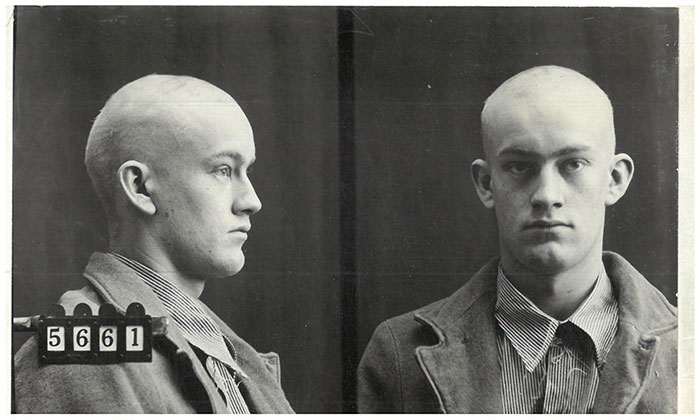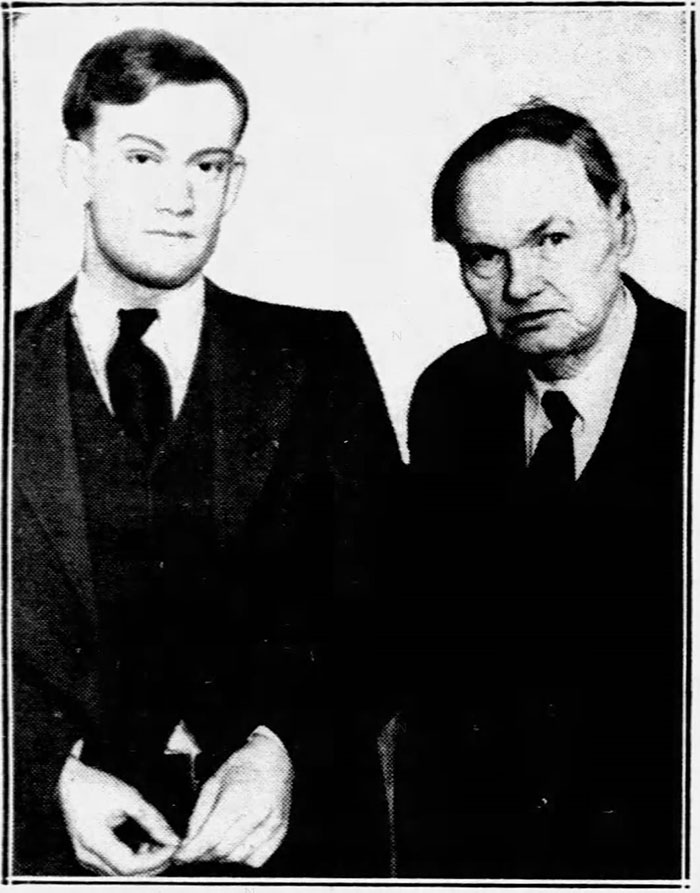Supreme Court Historic Preservation Commission Receives Donation for Historic Clarence Darrow Case
The Illinois Supreme Court Historic Preservation Commission received a donation of a 26-page typed transcription of Clarence Darrow’s passionate argument to save his 17-year-old client Russell McWilliams from the electric chair. After three sentencing hearings and two appearances before the Illinois Supreme Court, McWilliams narrowly escaped becoming the only minor executed in Illinois.
Attorney Peter F. Carroll in Woodstock, Illinois, donated the manuscript to the Illinois Supreme Court Historic Preservation Commission. Carroll had inherited a box of clippings that belonged to his grandfather, Winnebago County Judge William M. Carroll. The box contained various newspaper clippings, and a well-worn typewritten transcription sat at the bottom of the box. The title page identified the transcript as the closing argument delivered by Clarence Darrow in the Winnebago County Circuit Court in Rockford, Illinois.
“It’s a remarkable oration from one of the greatest trial attorneys of the early 20th century,” Carroll said.
After some in-depth research, Samuel Wheeler, Ph.D., Director of History Programs for the Commission, concluded Darrow’s speech was given on February 10, 1933, at McWilliams third sentencing hearing.

Intoxicated 17-year-old Russell Robert McWilliams boarded a streetcar in Rockford, pulled a gun, and demanded money from passengers. As he was exiting the car, he fatally shot 66-year-old streetcar conductor William Sayles. When he was arrested a few hours later, McWilliams readily confessed to the murder and pleaded guilty in court. After a brief sentencing hearing, Judge Arthur E. Fisher condemned the youth to die in the electric chair.
The case ignited a nationwide debate over the ethics of executing juvenile offenders. Prominent reformers Julia Lathrop, Jane Addams, and Jessie Binford argued that the sentence was inhumane and threatened to undo the progress they had made in reforming the juvenile justice system in Illinois. They recruited Clarence Darrow, an outspoken opponent of capital punishment, to take the case on appeal.
In People v. McWilliams, 348 Ill. 33 (1932), the Court remanded the case for a more substantive sentencing hearing that would consider both aggravating and mitigating factors. When the case returned to Rockford, McWilliams’ defense team requested a change of venue, citing judicial bias, but Judge Fisher denied the request. The second sentencing hearing again resulted in a death sentence. Darrow again appealed the decision, and the Illinois Supreme Court again agreed with him, ruling that the change of venue should have been granted, 350 Ill. 628 (1932). The sentence was reversed, and the case was remanded to the circuit court with instructions to grant the request for a new judge.
The third sentencing hearing began on February 7, 1933, and lasted for four days before Judge Edward D. Shurtleff. Darrow presented evidence of McWilliams’ difficult childhood, lack of educational opportunities, extreme youth, and the influence of alcohol as mitigating factors. By the time closing arguments arrived on February 10, Darrow was exhausted but still managed to deliver an eloquent plea to save the boy’s life. Several quotes from his closing argument appeared in newspapers, but no complete transcript has emerged until now.
Judge Shurtleff announced the sentence on February 18. He began the hearing by reading a long statement in which he said McWilliams showed “a disregard for human life” in committing the crime. He sentenced McWilliams to death for the third time, to be carried out on April 21, 1933.
Darrow was not in the courtroom when the sentence was pronounced. He was at home, still recovering from his efforts in the courtroom. When a reporter contacted him and told him of the verdict, Darrow replied, “I expected it. I thought that was the state of mind of the court.” Darrow told the reporter the defense team would continue to work on McWilliams’ behalf.

On April 11, 1933, Darrow appeared on McWilliams’ behalf before the 10-member state board of pardons. He asked the state pardon board to maintain Illinois record of never executing anyone under 18 years of age. He described McWilliams as a “boy who loves life, who never had a chance, and who was sentenced to death without the bat of an eye.” With his voice quivering, Darrow asked the state to “protect its young, not kill them.”
The next day, Darrow met directly with newly elected Illinois Governor Henry Horner to plead for clemency. Three days before the death sentence would be carried out, April 18, 1933, and Darrow’s 76th birthday, Governor Horner commuted McWilliams’ death sentence to 99-years in prison. Darrow said it was the “best birthday present” he could imagine.
Progressive reformers never stopped advocating for McWilliams’ release, arguing that his youth, clean prison record, and productive work in the prison greenhouse justified another chance at freedom. Their requests were repeatedly denied until 1950, when Governor Adlai Stevenson cut 42 years off the sentence, making McWilliams immediately eligible for parole.
Released in early 1951 after serving 19 of his 36 years behind bars, McWilliams married a social worker who had befriended him while he was incarcerated, moved to Massachusetts, and worked as an orchid grower, florist, and operated his own landscaping business. He lived a crime-free life until his death in 1997, at the age of 82. McWilliams case remains a significant example of the complexities and challenges of juvenile justice and capital punishment in Illinois.
The Illinois Supreme Court Historic Preservation Commission assists and advises the Supreme Court of Illinois in acquiring, collecting, preserving, and cataloging documents, artifacts and information relating to the Illinois judiciary.

